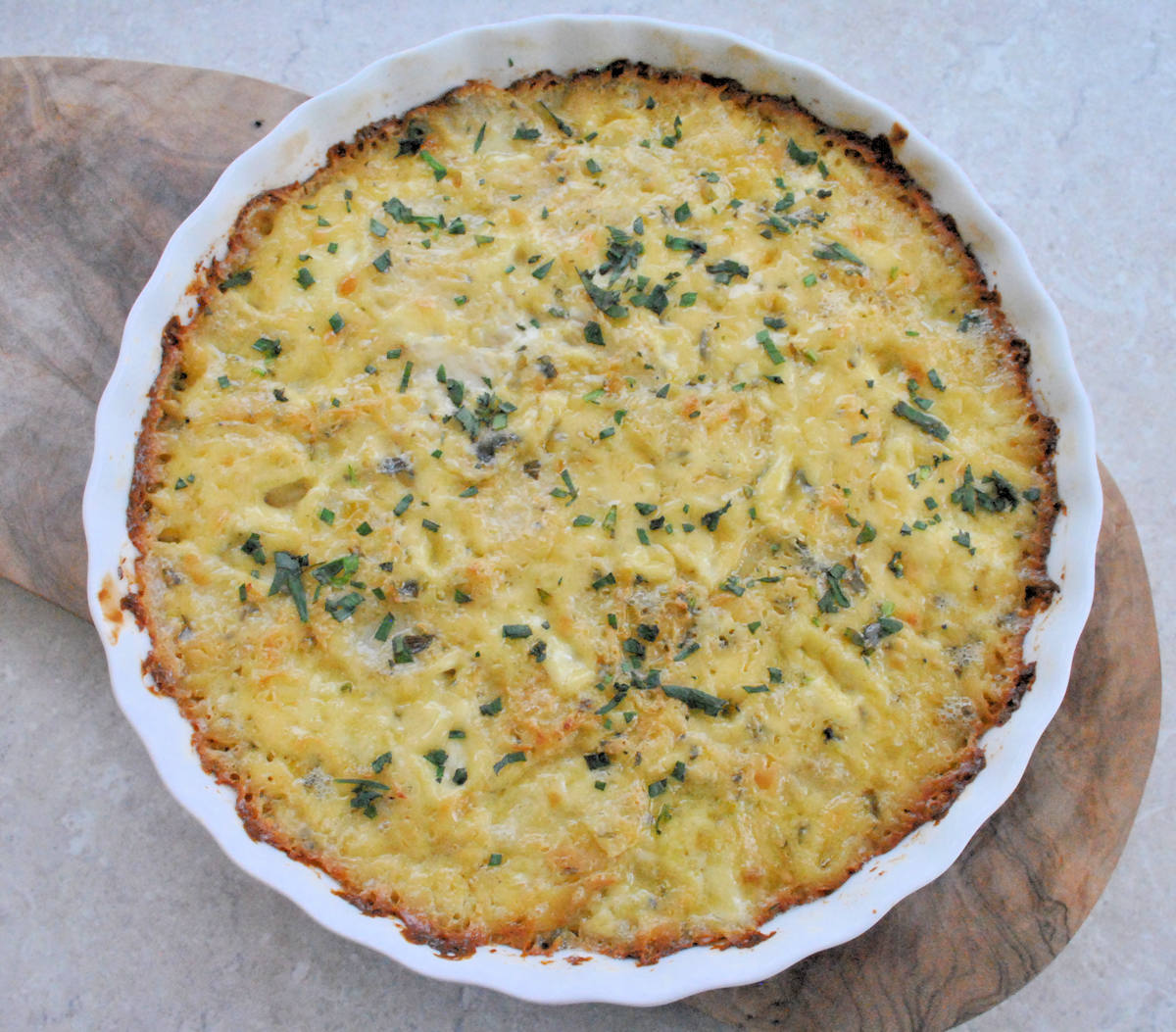Creamed Jerusalem artichoke gratin, with the tubers cooked twice: simmered in cream, then gratinéed in the oven.

Trouble with Jerusalem artichokes
I see them sometimes on market stalls looking unloved. Not very surprising: they look gnarly, they are a pain to peel, and they give you gas. Also, the confusion between them and the noble globe artichokes might cause uncertainty about how to cook them.
And they are a trouble to cook too. If you parboil them, they may disintegrate. If you roast them from raw, they’ll end up tough. But they are definitely worth the trouble, because few other root vegetables taste so wonderfully nutty and become as smoothly creamy, with the right cooking approach.
And this is it: first simmered in cream, then baked in the oven, they make a wonderful gratin. You can cook potatoes in the same way too: in fact it was the New York Times creamed potato recipe that inspired me.
Jerusalem fartichokes
Infamously (but deservedly) these root vegetables cause the most tremendous wind. That’s because they contain high levels of inulin, a soluble fibre that excites the gut bacteria into a frenzy of methane-release. Which is actually very good for the gut, but not so much for those in the same room as the artichoke eater.
There isn’t that much that can be done to eliminate this feature, other than trying to fart in the privacy of your bathroom. To some extent, seeds like fennel or caraway will help matters, as well as tarragon, liberally used in this recipe. And the cooking method matters: if cooked twice, Jerusalems tend to lose a little of their explosive qualities.
How to prepare the chokes
For this dish, the artichokes should be peeled: peeling and slicing them is the biggest effort as they usually want to do neither.
I know that knobbly vegetables taste the same as perfectly formed and smooth ones, but tell that to the kitchen peeler. And I know what I’m talking about having grown root veg for years: they come much gnarlier from the kitchen garden than from the Sainsbury’s shelves.
But seeing as they are quite cheap, buy enough to allow for the peeling waste. Or spend half the morning picking the smooth and straight ones from the market stall which won’t make the fellow behind it happy.
Once peeled, take care slicing them: they are quite preternaturally hard. A mandolin is my slicing tool of choice, or a sharp knife and good knife skills.
How to make creamed Jerusalem artichokes
It takes some effort but as an outcome, it’s the best I can ever manage with Jerusalem artichokes, because this method cooks them through to tenderness but without them falling to bits or turning to mush, as otherwise often happens. Plus, as indicated above, the double cooking reduces somewhat the vegetable’s antisocial side effects.
With the company of alliums, garlic leeks and onion or shallots, first softened in butter, the artichoke slices should simmer in cream for about ten to fifteen minutes, until almost tender.
Then they will need to be drained and transferred into a gratin dish with some of the cream they have been cooking in, just to cover the tubers. Press them down in the dish, cover with foil and bake in the oven for about half an hour.
Following that, the final blast to make it all look and taste a bit more caramelised, with the foil cover taken off, will take about ten minutes. Et voila! Let them stand for a few minutes, then serve as an unusual and delicious side.
More creamy vegetable gratin recipes
Celeriac gratin recipe with cream, garlic and grated cheese. Celeriac tastes a bit earthy and is also suitable for a mash or puree, celeriac fondant or celeriac soup.
Beetroot gratin, thinly sliced beets baked in garlic and dill-infused cream, a gorgeous side to a fish course. No need to pre-cook the beetroot.
Green bean casserole is so good when homemade and cooked from scratch! Creamy mushroom sauce is easy to make, while blanching then drying fresh green beans stops them from being soggy.
More root vegetable recipes
Salt baked celeriac, sweet and earthy and a Michelin grade impressive centrepiece dish. Salt crust dough made from flavoured salt and flour, you crack it open like an enormous soft boiled egg. Or a pathologist opening the skull.
Deep fried parsnip fries are a delicious alternative to potato chips. Parsnip fries with gutsy seasoning are healthier than potato chips and can be also made in an air fryer.
Roasted root vegetables with spiced bulgur wheat are a vibrant winter dish. It’s the classic Christmas roast vegetable medley with a summery vibe.